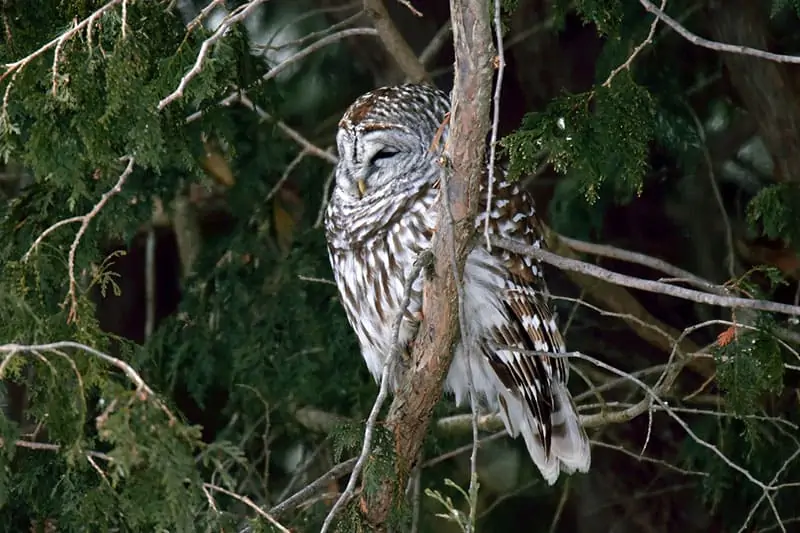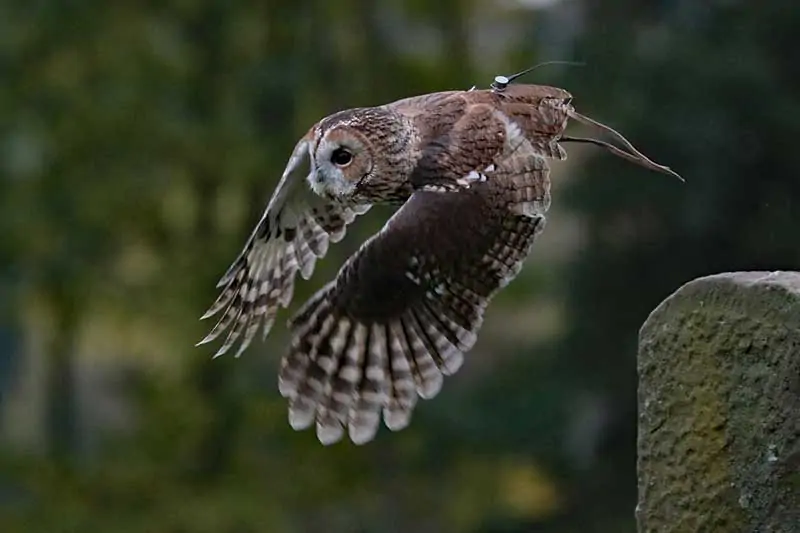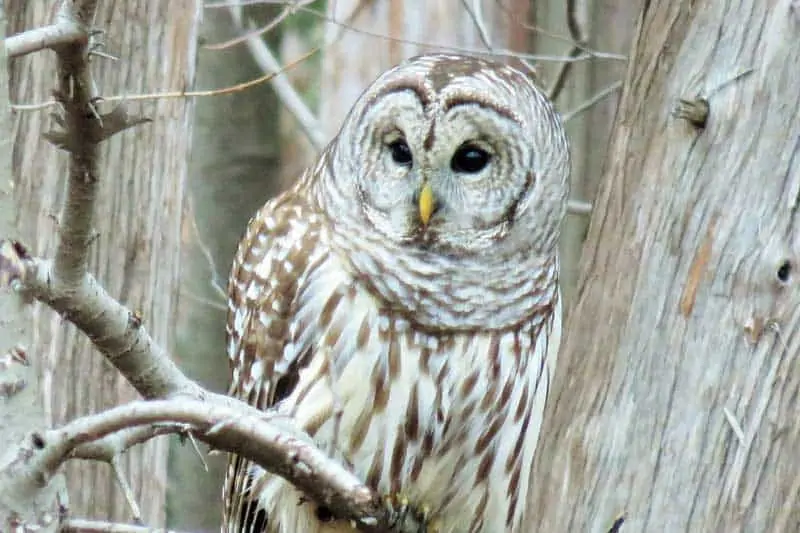If you’re ever lucky enough, you’ll get to see barred owls in action as amazing hunters, beautiful animals. Not just birdwatchers are interested in seeing these magnificent predators. Barred owls may have been right in front of your face, but you’ll never know because their plumage is perfect for blending. To help you learn more about this bird and possibly increase your odds of identifying one, we compiled 35 facts about Barred Owls.
35 QUICK FACTS ABOUT BARRED OWLS
1. The vertical and horizontal bars on the abdomen and chest of barred owls earned them their name.
2. The striped owl, Northern barred owl, and sometimes a hoot owl are all terms used to describe barred owls.
3. Strix varia is the scientific name for them.
4. Barred owls are around 19 to 21 inches long, weigh about 1.6 pounds each, and have a wingspan of about 33 to 43 inches.
5. They have large eyes and excellent depth perception, since their eyes are tube-shaped like binoculars, allowing more light to get in during the night. One of the owls’ most outstanding adaptations is its eyes, which have evolved to be perfect predators.

6. Did you know that barred owls have asymmetrical ears to triangulate sound? They have exceptional hearing. The higher ear is positioned on top of the head, while the lower ear is positioned on bottom. Their prey’s precise location is thus helped to be heard.
7. The sense of smell in Barred Owls is terrible.
8.Small animals, birds, amphibians, reptiles, even gigantic insects and fish are all hunted by Barred Owls.
9. Barred owls have dark eyes and are massive birds with rounded heads and mottled brown and white plumage.
10. They may be found presently in Northwest America, where they formerly lived in the north.
11. The Texas, Florida, and Mexican barred owls are the three subspecies of Northern barred owls.
12. One of more than 200 species of owls is the barred owl.

13.The sound of a Barred Owl is described as “Who cooks for you?” “Who cooks for you all?”
14.Barred owls, which have been known to dive-bomb people when they sense threatened, can be territorial and dangerously aggressive towards humans.
15. The Barred owl is thought to be a protective bird.
16.Barred Owls generally do not breed until they are at least two years old.
17. Barred owls lay one clutch of one to five eggs each year from March to August.
18. Barred owls are the only owl species that will care for their offspring for four months.
19. One pair can be together for up to 20 years because they will mate for life.
20. Pine, spruce, fir, and cedar woods are home to barred owls. They must locate large trees with cavities for nesting in mature, thick woods.
21. By holding the bark with their beak and talons and flapping their wings, young Barred Owls may walk their way up a tree’s trunk.

22. A large owl can carry up to 4 times its weight.
23.Little cats and dogs are welcome to the barred owl.
24. These owls can be found roosting on branches and in tree cavities throughout the day, hunting mostly at night.
BARRED OWL TIPS
Tips for Attracting Owls
- Provide nesting boxes for birds.
- Bigger older trees should not be cut down or pruned.
- Provide a birdbath, or at least some water.
- Give them excellent hunting grounds by creating a yard with abundant plants and foliage.
You can scare barred owls off by
- Using strobe lighting, the operator can adjust the color temperature.
- Remove bird feeders since they are not attracting other birds.
- Making a lot of noise can be achieved in one of two ways:
- It’s best to keep small pets indoors.
- Nests and roosting sites should be removed.
25. While moving into the Pacific Northwest, barred owls have displaced spotted owls. Disrupting the spotted owls’ nesting, barred owls are a larger and more aggressive species. Spotted owls, who were already endangered owing to habitat destruction, are being driven away by this and their struggle for food.
26. When it flies, barred owls may go unnoticed. They’re extremely quiet. The structure of Barred Owl feathers acts as a silencer, allowing them to move at slower speeds without flapping. Their wing feathers have comb-like serrations that chop up the air, producing a swoosh sound.
27. One of the major concerns for the Barred Owl is the Great Horned Owl.
28.When a Great Horned Owl is nearby, a Barred Owl will relocate to another part of its territory.

29. For at least 11,000 years, Barred Owls have been around. Florida, Tennessee, and Ontario have all unearthed Pleistocene fossils.
30. Barred Owls are permanent residents who have only moved a few kilometers throughout their lives. They don’t migrate and will live in the same place for their whole lives.
31. At least 24 years old, the oldest known Barred Owl was discovered. In 1986, it was caught in Minnesota and recovered dead, entangled in fishing equipment, in 2010.
32.With their population increasing, the Barred owls’ conservation status has been changed to leased-concerned.
33.Owls hoot to establish their dominance, connect with their partner, and send out warning signals.
34. For many years, Barred Owls will keep the same range and several breeding sites.
35.Because they can’t move their eyes, barred owls bob their heads. This enables them to see and perceive things that they couldn’t ordinarily do.
